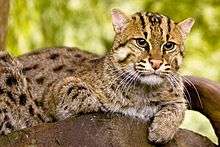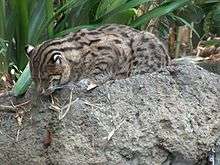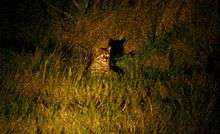Fishing cat
| Fishing cat | |
|---|---|
 | |
| Scientific classification | |
| Kingdom: | Animalia |
| Phylum: | Chordata |
| Class: | Mammalia |
| Order: | Carnivora |
| Suborder: | Feliformia |
| Family: | Felidae |
| Subfamily: | Felinae |
| Genus: | Prionailurus |
| Species: | †P. viverrinus |
| Binomial name | |
| Prionailurus viverrinus (Bennett, 1833) | |
The fishing cat (Prionailurus viverrinus) is a medium-sized wild cat of South and Southeast Asia. Since 2016, it is listed as Vulnerable on the IUCN Red List. Fishing cat populations are threatened by destruction of wetlands and have declined severely over the last decade.[1] Fishing cats live foremost in the vicinity of wetlands, along rivers, streams, oxbow lakes, in swamps, and mangroves.[2]
The fishing cat is the state animal of West Bengal.[3]
Characteristics

The fishing cat is the largest of the Prionailurus cats. Its coarse fur is olive-grey to ashy-grey with darker stripes on the shoulder and roundish or oval-shaped spots on the flanks and sides. The short and rounded ears are set low on the head, and the back of the ears have a white spot. Two stripes are on the cheeks, and four stripes run from above the eyes between the ears to the shoulder. The underside is white, and around the throat are two rows of spots. The tail is short, less than half the length of head and body, spotted at the base and with a few black rings at the end.[4] It is about twice the size of a domestic cat and stocky and muscular with medium to short legs. Its face is elongated. Its head-to-body length typically ranges from 57 to 78 cm (22 to 31 in), with a tail of 20 to 30 cm (7.9 to 11.8 in). It weighs from 5 to 16 kg (11 to 35 lb).[5] The underside fur is longer and often overlaid with spots.[6]
Its paws are less completely webbed than those of the leopard cat, and the claws are incompletely sheathed so that they protrude slightly when retracted.[4] Webbed feet have often been noted as a characteristic of the fishing cat, but the webbing beneath the toes is not much more developed than that of a bobcat.[7]
Distribution and habitat

The fishing cat is broadly but discontinuously distributed in Asia, and is primarily found in the Terai region of the Himalayan foothills in India and Nepal, in eastern India, Bangladesh and Sri Lanka. There are no confirmed records from Peninsular Malaysia, Vietnam and Laos.[1][8]
In India, the presence of fishing cats has been documented in Ranthambhore Tiger Reserve, in Sur Sarovar Bird Sanctuary, outside protected areas in West Bengal, in and around Krishna Wildlife Sanctuary, in Coringa Wildlife Sanctuary and adjoining reserve forests in Andhra Pradesh.[9][10][11][12][13][14][15]
Populations have also been documented along the coast in Thailand.[16] Fishing cats were the least detected cats with only six photos obtained altogether in Kaeng Krachan National Park, Khao Sam Roi Yot National Park and Thale Noi Non-Hunting Area.[17] In March 2003, a single fishing cat was photographed by a camera trap in Kulen Promtep Wildlife Sanctuary, northern Cambodia.[18] In 2008, a fishing cat kitten was found in Botum-Sakor National Park, southwest Cambodia.[19] In 2015, fishing cats were also recorded in a coastal wetland in Cambodia.[20]
In 2012, a fishing cat was recorded in Sindh Province, Pakistan.[21]
Reports in Bangladeshi newspapers indicate that fishing cats live in all divisions of Bangladesh but are severely threatened; villagers killed at least 30 fishing cats between January 2010 and March 2013.[22]
The island of Java constitutes the southern limit of fishing cat range, but by the 1990s fishing cats were scarce and apparently restricted to tidal forests with sandy or muddy shores, older mangrove stands, and abandoned mangrove plantation areas with fishponds.[23]
Fishing cats are strongly associated with wetlands, typically inhabit swamps and marshy areas, around oxbow lakes, reed beds, tidal creeks and in mangrove forests; they seem less abundant around smaller, fast-moving watercourses. Most records are from lowland areas. Although fishing cats are widely distributed through a variety of habitat types including both evergreen and tropical dry forest, their occurrence tends to be highly localized.[2]
Ecology and behavior

The fishing cat is thought to be primarily nocturnal, and is very much at home near water. It can swim long distances, even under water. Adult males and females without dependent young are solitary. Females have been reported to range over areas of 4 to 6 km2 (1.5 to 2.3 sq mi), while males range over 16 to 22 km2 (6.2 to 8.5 sq mi). Adults have been observed to make a "chuckling" sound.[5]
Fishing cats have been observed while hunting along the edges of watercourses, grabbing prey from the water, and sometimes diving into the water to catch prey further from the banks.[24] Their main prey is fish; scat collected in India's Keoladeo National Park revealed that fish comprises approximately three-quarters of their diet, with the remainder consisting of birds, insects, and small rodents. Molluscs, reptiles including snakes, amphibians and carrion of domestic cattle supplement their diet.[25]
They mark their territory using cheek-rubbing, head rubbing, chin rubbing, neck rubbing and urine-spraying to leave scent marks. They also sharpen their claws and display flehmen behavior.[26]
Reproduction and development
Wild fishing cats most likely mate during January and February; most kittens in the wild were observed in March and April.[5] In captivity, the gestation period lasts 63–70 days; females give birth to two or three kittens.[26] They weigh around 170 g (6.0 oz) at birth, and are able to actively move around by the age of one month. They begin to play in water and to take solid food when about two months old, but are not fully weaned until six months old. They reach full adult size when about eight and a half months old, acquire their adult canine teeth by 11 months, and are sexually mature when approximately 15 months old. They live up to 10 years in captivity.[5]
Threats
The Fishing cat is threatened by destruction of wetlands, which are increasingly being polluted and converted for agricultural use and human settlements. In Andhra Pradesh, target killing of fishing cats is prevalent in some areas where there is human/animal conflict. Over-exploitation of local fish stocks and retaliatory killing are also significant threats.[1] In West Bengal's Howrah district, 27 dead fishing cats were recorded between April 2010 and May 2011.[27] In Bangladesh, at least 30 fishing cats were killed by local people in three years between January 2010 and March 2013.[22]
The fishing cat is possibly extinct in coastal Kerala, India.[28]
Conservation
Prionailurus viverrinus is included on CITES Appendix II, and protected by national legislation over most of its range. Hunting is prohibited in Bangladesh, Cambodia, China, India, Indonesia, Myanmar, Nepal, Pakistan, Sri Lanka, Thailand. Hunting regulations apply in Lao PDR. In Bhutan and Vietnam, the species is not protected outside protected areas.[2]
In captivity

Fishing cat captive breeding programmes have been established by the European Association of Zoos and Aquaria and the American Association of Zoos and Aquariums. All the fishing cats kept in zoos around the world are listed in the International Studbook of the World Association of Zoos and Aquariums.
Local names
In Assamese language, the fishing cat is known as meseka (Assamese: মেচেকা), probably derived from mas (Assamese: মাছ) meaning "fish".
In Bengali language, the fishing cat is known as "mach-baghrol" and "bagh-dasha".[29] "Mācha" means "fish", and "bāgha" means "tiger".[30]
In Hindi languages, it is known as "bunbiral" and "khupya bagh".[31]
In Telugu language, it is called "bavuru pilli" meaning "wild cat".[32]
In Sinhala language, the fishing cat is known as "handun diviya".[33]
In Thai language, it is called "suea pla" (Thai: เสือปลา; RTGS: suea pla), literally "fish tiger".[34] In Myanmar language, it is called "Kyaung-ta-nga" "ကြောင်တံငါ" "Kyaung" means "cat" and "ta-nga" means "fisherman".
References
- 1 2 3 4 Mukherjee, S.; Appel, A.; Duckworth, J.W.; Sanderson, J.; Dahal, S.; Willcox, D.H.A.; Herranz Muñoz, V.; Malla, G.; Ratnayaka, A.; Kantimahanti, M.; Thudugala, A.; Thaung, R. & Rahman, H. (2016). "Prionailurus viverrinus". IUCN Red List of Threatened Species. Version 2017-3. International Union for Conservation of Nature. doi:10.2305/IUCN.UK.2016-2.RLTS.T18150A50662615.en
- 1 2 3 Nowell, K.; Jackson, P. (1996). "Fishing Cat, Prionailurus viverrinus (Bennett, 1833)". Wild Cats: status survey and conservation action plan (PDF). Gland, Switzerland: IUCN/SSC Cat Specialist Group. pp. 74−76. ISBN 2-8317-0045-0.
- ↑ Wildlife Institute of India. "State animals, birds, trees and flowers" (PDF). Wildlife Institute of India. Archived from the original (PDF) on 15 June 2007. Retrieved 5 March 2012.
- 1 2 Pocock, R. I. (1939). "Prionailurus". The Fauna of British India, including Ceylon and Burma. Mammalia. – Volume 1. London: Taylor and Francis, Ltd. pp. 265–284.
- 1 2 3 4 Sunquist, M.; Sunquist, F. (2002). "Fishing Cat Prionailurus viverrinus (Bennett, 1833)". Wild Cats of the World. Chicago: University of Chicago Press. pp. 241–245. ISBN 0-226-77999-8.
- ↑ Burnie, D.; Wilson, D. E. (2001). Animal: The Definitive Visual Guide to the World's Wildlife. Washington, D.C.: Smithsonian Institution. ISBN 0-7894-7764-5.
- ↑ Kitchener, A. C. (1998). The Natural History of the Wild Cats. Ithaca, New York: Cornell University Press.
- ↑ Duckworth, J. W.; Stones, T.; Tizard, R.; Watson, S. & Wolstencroft, J. (2010). "Does the fishing cat inhabit Laos?". Cat News. 52: 4–7.
- ↑ Sadhu, A.; Reddy, G. V. (2013). "First evidence of Fishing Cat in the Ranthambhore Tiger Reserve, Rajasthan, India". Cat News. 58: 36–37.
- ↑ Sharma, P.; Raj, B.; Sharma, V.; Seshamani, G. & Satayanarayan, K. (2016). "First record of Fishing Cat in Sur Sarovar Bird Sanctuary, Agra, India". Cat News. 63: 19–20.
- ↑ Adhya, T. (2011). Status survey of Fishing Cat (Prionailurus viverrinus) in Howrah and Hooghley, West Bengal (PDF). India: Intermediate report submitted to the Small Grants Programme, WWF.
- ↑ Kantimahanti, M. (2016). "Community-based Fishing Cat conservation in the Eastern Ghats of South India". In A. Appel; J. W. Duckworth. Proceedings of the First International Fishing Cat Conservation Symposium, 25–29 November 2015, Nepal (PDF). Bad Marienberg, Germany and Saltford, Bristol, United Kingdom: Fishing Cat Working Group. pp. 51–54.
- ↑ Malla, G.; Sivakumar, K. (2014). "The Coringa Mangroves—realm of the Fishing Cat". Sanctuary Asia. XXXIV (6).
- ↑ Malla, G. (2016). "Ecology and conservation of Fishing Cat in Godavari mangroves of Andhra Pradesh". In A. Appel; J. W. Duckworth. Proceedings of the First International Fishing Cat Conservation Symposium, 25–29 November 2015, Nepal (PDF). Bad Marienberg, Germany and Saltford, Bristol, United Kingdom: Fishing Cat Working Group. pp. 48–50.
- ↑ Sathiyaselvam, P.; Eswar Satyanarayana, J. (2016). Status of Fishing Cat and Indian Smooth-coated Otter in Coringa Wildlife Sanctuary (PDF). Kakinada: EGREE Foundation. Archived from the original (PDF) on 2016-09-24. Retrieved 2016-09-24.
- ↑ Cutter, P.; Cutter, P. (2010). "Recent sightings of fishing cats in Thailand". Cat News. 51: 12–13.
- ↑ Lynam, A. J.; Jenks, K. E.; Tantipisanuh, N.; Chutipong, W.; Ngoprasert, D.; Gale, G. A.; et al. (2012). "Terrestrial activity patterns of wild cats from camera-trapping" (PDF). Raffles Bulletin of Zoology: 407–415. Archived from the original (PDF) on 2014-02-01.
- ↑ Rainey, H. J.; Kong, K. (2010). "A fishing cat observation from northern Cambodia" (PDF). Cat News. 52: 8–9. Archived from the original (PDF) on 2016-03-19. Retrieved 2011-10-23.
- ↑ Royan, A. (2009). "Confirmation of the endangered fishing cat in Botum-Sakor National Park, Cambodia" (PDF). Cat News. 51: 10–11.
- ↑ Thaung R.; Herranz Muñoz, V. (2016). "Identifying priority sites and conservation actions for Fishing Cat in Cambodia". In A. Appel; J. W. Duckworth. Proceedings of the First International Fishing Cat Conservation Symposium, 25–29 November 2015, Nepal (PDF). Bad Marienberg, Germany and Saltford, Bristol, United Kingdom: Fishing Cat Working Group. pp. 37–40.
- ↑ Islam, S.; Nawaz, R. & Moazzam, M. (2015). "A survey of Smooth-coated Otter (Lutrogale perspicillata sindica) and Fishing Cat (Prionailurus viverrinus) in Chotiari Reservoir, Sanghar, Pakistan using camera traps". International Journal of Biology and Biotechnology. 12 (4): 579–584.
- 1 2 Chowdhury, S. U.; Chowdhury, A. R.; Ahmed S. & Muzaffar, S. B. (2015). "Human-fishing cat conflicts and conservation needs of fishing cats in Bangladesh". Cat News. 62: 4–7.
- ↑ Melisch, R.; Asmoro, P. B.; Lubis, I. R. & Kusumawardhani, L. (1996). "Distribution and status of the Fishing Cat (Prionailurus viverrinus rhizophoreus Sody, 1936) in West Java, Indonesia (Mammalia: Carnivora: Felidae)" (PDF). Faunistische Abhandlungen, Staatliches Museum für Tierkunde Dresden. 20 (17): 311–319. Archived from the original (PDF) on 2013-03-23. Retrieved 2011-04-24.
- ↑ Mukherjee, S. (1989). Ecological separation of four sympatric carnivores in Keoladeo Ghana National Park, Bharatpur, Rajasthan, India. MSc. Thesis, Wildlife Institute of India.
- ↑ Haque, N. M., Vijayan, V. (1993). Food habits of the fishing cat Felis viverrina in Keoladeo National Park, Bharatpur, Rajasthan. Journal of the Bombay Natural History Society 90: 498–500.
- 1 2 Mellen, J. D. (1993). "A Comparative Analysis of Scent-Marking, Social and Reproductive Behavior in 20 Species of Small Cats (Felis)". American Zoologist. 33 (2): 151–166. doi:10.1093/icb/33.2.151. JSTOR 3883837.
- ↑ Mukherjee, S., Adhya, T., Thatte, P. and Ramakrishnan, U. (2012). Survey of the Fishing Cat Prionailurus viverrinus Bennett, 1833 (Carnivora: Felidae) and some aspects impacting its conservation in India. Journal of Threatened Taxa 4 (14): 3355–3361.
- ↑ Janardhanan, R., Mukherjee, S., Karunakaran, P. V., Athreya, R. (2014). On the occurrence of the Fishing Cat Prionailurus viverrinus Bennet, 1833 (Carnivora: Felidae) in coastal Kerala, India. Journal of Threatened Taxa 6 (3): 5569–5573.
- ↑ Jerdon, T. C. (1874). Felis viverrina The Mammals of India. J. Wheldon, London.
- ↑ Biswas, S. (2000). mācha bāgha In: Samsad Bengali-English Dictionary. 3rd ed. Calcutta, Sahitya Samsad.
- ↑ Sterndale, R. A. (1884). Felis viverrina Natural History of the Mammalia of India and Ceylon. Thacker, Spink, and Co., Calcutta. Pp. 187–188.
- ↑ Brown, C. P. (1903). A Telugu-English Dictionary (2nd ed.). Madras: Promoting Christian Knowledge. p. 763. Retrieved 6 December 2016.
- ↑ Bambaradeniya, C. N. B. (2006). Prionailurus Severtzov, 1858 The Fauna of Sri Lanka: Status of Taxonomy, Research, and Conservation. Colombo: IUCN.
- ↑ Jewett, K. (2016). "Fishing Cat's Cradle". Bangkok Post. Retrieved 2016-12-06.
External links
| Wikimedia Commons has media related to Prionailurus viverrinus. |
| Wikispecies has information related to Prionailurus viverrinus |
- IUCN/SSC Cat Specialist Group: Fishing cat Prionailurus viverrinus
- Fishing Cat Working Group
- ARKive: Prionailurus viverrinus with images and movies
- BioGraphic: Fishing Cat's Cradle by Morgan Heim and Katie Jewett, October 2016

